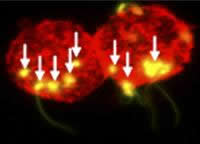Sperm may play leading role in spreading HIV
26-Oct-2009 - Sperm, and not just the fluid it bathes in, can transmit HIV to macrophages, T cells, and dendritic cells (DCs), report
a team led by Ana Ceballos at the University of Buenos Aires in Argentina. By infecting DCs, which carry the virus and potently pass it to T cells, sperm
may play a leading role in spreading HIV. The article appears in the November 23, 2009 issue of the Journal of Experimental Medicine (online October 26).
 During
sexual intercourse, HIV-infected men transmit HIV through their semen, which carries free-floating virus as well as HIV-infected leukocytes. Traces of HIV have been detected on sperm as well, but
the role they play in viral transmission has been a matter of debate. After all, men with vasectomies can transmit HIV. Now, Ceballos et al. show that HIV attaches to the surface of sperm and that these HIV carriers pass on the virus to DCs and other HIV targets. During
sexual intercourse, HIV-infected men transmit HIV through their semen, which carries free-floating virus as well as HIV-infected leukocytes. Traces of HIV have been detected on sperm as well, but
the role they play in viral transmission has been a matter of debate. After all, men with vasectomies can transmit HIV. Now, Ceballos et al. show that HIV attaches to the surface of sperm and that these HIV carriers pass on the virus to DCs and other HIV targets.
Sperm express molecules known to interact with HIV's envelope, such as heparan sulfate and mannose receptors. The authors show that HIV relies on heparan sulfate to attach to sperm, but not mannose receptors as previously predicted.
Once attached, the virus was transmitted from sperm to DCs in culture. The DC receptors CD4 and DC-SIGN were required for transmission, suggesting that DCs pick up the virus by binding to sperm rather than by ingesting them. DCs matured after
interacting with the sperm, producing tolerance-promoting cytokines like interleukin-10. The authors speculate that this immune-suppressing profile, versus an inflammatory profile, might also help the virus spread.
Sperm might reach DCs by passing through microabrasions in the vaginal or anal lining that often form during intercourse, suggest the authors. Or they might contact the finger-like projections of DCs that extend to the
surface of mucosal linings. Furthermore, the team found that a slightly acidic pH, similar to the pH in the vagina after sex, promoted HIV-sperm binding and the subsequent rate of sperm-related DC infection.
###
About the The Journal of Experimental Medicine
The Journal of Experimental Medicine (JEM) is published by the Rockefeller University Press. All editorial decisions on manuscripts submitted are made
by active scientists in conjunction with our in-house scientific editors. JEM content is posted to PubMed Central, where it is available to the public
for free six months after publication. Authors retain copyright of their published works and third parties may reuse the content for non-commercial purposes
under a creative commons license. For more information, please visit www.jem.org.
Ceballos, A., et al. 2009. J. Exp. Med. doi:10.1084/jem.20091579.
CONTACT:
Rita Sullivan
news@rupress.org
212-327-8603
Rockefeller University Press
Source: EurekAlert
http://www.eurekalert.org/pub_releases/2009-10/rup-smp102009.php
|